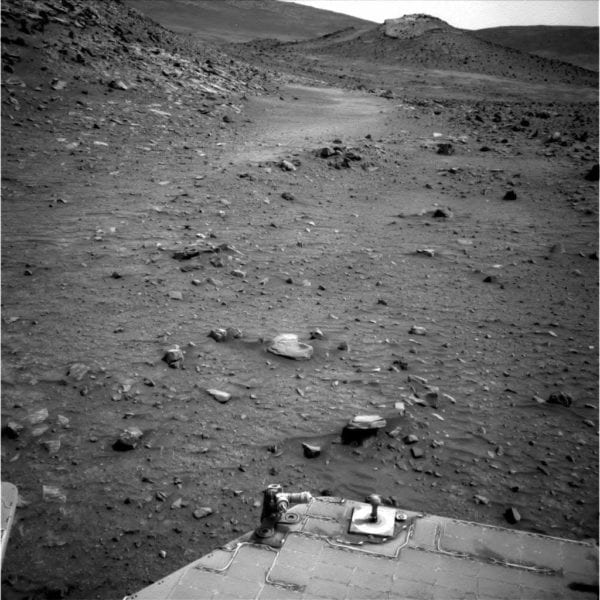Mars Research Expands Insights Into Earth’s Surface Processes

The drive to learn how the sun weathers rock has taken UNC Charlotte earth scientist Martha-Cary “Missy” Eppes to great lengths – to the arid deserts of the Southwest, the periglacial boulder fields of Pennsylvania and Virginia, and even to the surface of Mars – at least virtually.
Mechanical weathering, the physical means by which rock is broken into smaller fragments, is one of the primary processes that defines Earth as we know it. Without it, there would be no erosion, no soil, no sediment from which resources like water and oil can be readily drawn, and no ready access to rock nutrients that are required by flora and in turn, fauna.
Studying the basic mechanisms that drive weathering can therefore lead to a more profound understanding of our planet.
 “Endeavors like this hold the potential to open doors of understanding that we would not even know existed if we hadn’t gone down the road,” Eppes said. “This potential for discovery is the foundation of knowledge-building that universities like UNC Charlotte are uniquely poised to support.”
“Endeavors like this hold the potential to open doors of understanding that we would not even know existed if we hadn’t gone down the road,” Eppes said. “This potential for discovery is the foundation of knowledge-building that universities like UNC Charlotte are uniquely poised to support.”
As a soil scientist and geomorphologist, Eppes wanted to understand the impact the sun has on this fundamental Earth surface process. She had noticed that cracks in rocks on Earth seemed to be tied to the sun’s movement from east to west. Her theory challenged the long-standing conventional view that thermal stresses caused by the sun are too low to cause weathering.
“If you go out and start measuring the orientations on cracks and rocks on Earth and you exclude variables related to tectonics, it turns out that most cracks are oriented in the Northeast-Southwest direction,” Eppes says.
“Holy Cow!” Moment
The findings that Eppes and her colleagues have made on Earth are detailed in the Geological Society of America Bulletin, Geomorphology and Earth Surface Processes and Landforms. Meanwhile, Eppes was inspired to look further.
“The Mars Rover landed on Mars, and I saw that one of the first pictures taken was of a rock with a crack in it,” she says. “I thought, ‘Holy cow. I bet the same thing works on Mars as it does on Earth.’ I was extremely motivated to find out if cracks in rocks on Mars point North” (as the rocks on Earth do.)
While photographs and other data from the Spirit and Opportunity Rovers became available quickly, analyzing the data proved more difficult. No virtual tools existed. Eppes turned to Andrew Willis, a professor in Electrical and Computer Engineering, who with students’ help designed the software needed. Eppes and her students have used the software over the past few years to analyze data from the Mars missions.
The image analysis software enables users to browse the PANCAM image files recorded by the Rovers Spirit and Opportunity. Users can make 3D measurements from the recorded images. The data from the images is gathered in massive spreadsheets and analyzed.
“You basically can go and stroll around the surface of Mars and collect field data just like you were a field scientist walking along the surface of Mars,” Eppes says. “You can measure how big things are, or you can measure their orientation of planes, and you can measure distances across the ground surface.”
Taking a Closer Look
A decade after Eppes saw those first Mars images, she and Willis in 2015 published findings in the influential academic journal Nature Communications. Co-authors are Jamie Molaro of the Lunar and Planetary Laboratory at University of Arizona, UNC Charlotte undergraduate student Stephen Abernathy and doctoral student Beibei Zhou.
They considered1,857 cracks visible in 1,573 rocks along the path Spirit took, considering rock size, total number of visible cracks, and spatial data including the length and orientation of cracks.
“There was variance from image to image, but when you collect the average of so many thousands of cracks, then you start to see a clear picture,” says Abernathy, who recorded and analyzed the data.

This cluster of rocks called ‘Rock Garden’ is where NASA’s Mars Exploration Rover Spirit became embedded in April 2009. The Spirit and Opportunity rovers landed on the Red Planet in January 2004. Image Credit: NASA/JPL-Caltech
“It’s not something that every time you look at one of these rocks, it’s crystal clear and perfect and obvious,” he says. “It varies significantly from rock to rock, so that’s why we have to take so many data points. It’s the very large number of data points that allows us to actually pinpoint meaningful trends.”
They found that the Mars rock cracks are oriented in directions similar to those found in Earth rock cracks in mid-latitude deserts. A numerical model they developed also supported the hypothesis.
“We are able to say ‘Here is the actual crack that we can measure on the surface of Mars,’ ” Eppes says. “Also we can use physics and theory and predict those same cracks essentially. I think that is the important contribution, to show that it’s a viable and possibly key process of cracking rocks on other planets. It’s just the influence of the sun rising and setting on Mars just like it rises and sets on Earth.”
For Abernathy, who graduated in 2013 with a geology degree and who now works as a field geologist, the process helped him hone skills he has taken into his career.
“When you do a research project or independent study or anything like that, it really gives you a chance to put together all the things you’ve been learning that apply to a real world situation,” he says. “With geology at least, you take classes and you learn about things in the textbook, but a lot of times, it’s not until you actually go out in the field and start seeing things in the real world when it actually clicks into place.”
Eppes, now in 2016, is measuring cracking in real-time to gain more detailed observations, using acoustic emission sensors on boulders in pastures and in the desert. She also has made hypothetical cracks “grow” mathematically by using equations derived from mechanical engineering principles. She has learned that while cracks grow extremely slowly, the growth occurs at stresses much lower than a material’s laboratory-measured strength would imply.
She is teaming up with Russell Keanini of the Mechanical Engineering and Engineering Science Department at UNC Charlotte to model the fracture mechanics of rock cracking..
“The vast majority of weathering studies are concerned with the different factors in the environment that would induce a stress on a rock,” she says. “These are things like heating and cooling or freezing or frost shattering or unloading. But none of those are actually, in fact, the actual process that opens a crack. It’s fracture mechanics that dictates that. And so there’s this whole world, this whole undiscovered world of processes that weathering scientists haven’t really delved into.”
That is the world that will continue to pull Eppes in.
This story appeared in the Winter/Spring 2016 issue of the UNC Charlotte magazine. | Words: Stewart Shelton and Lynn Roberson | Image of Eppes: Lynn Roberson. Top image: A mosaic of the Valles Marineris hemisphere of Mars is projected into point perspective, a view similar to that which one would see from a spacecraft. The distance is 2500 kilometers from the surface of the planet. The mosaic is composed of Viking Orbiter images of Mars. The bottom of the scene shows the entire Valles Marineris canyon system. Image Credit: NASA/JPL-Caltech.